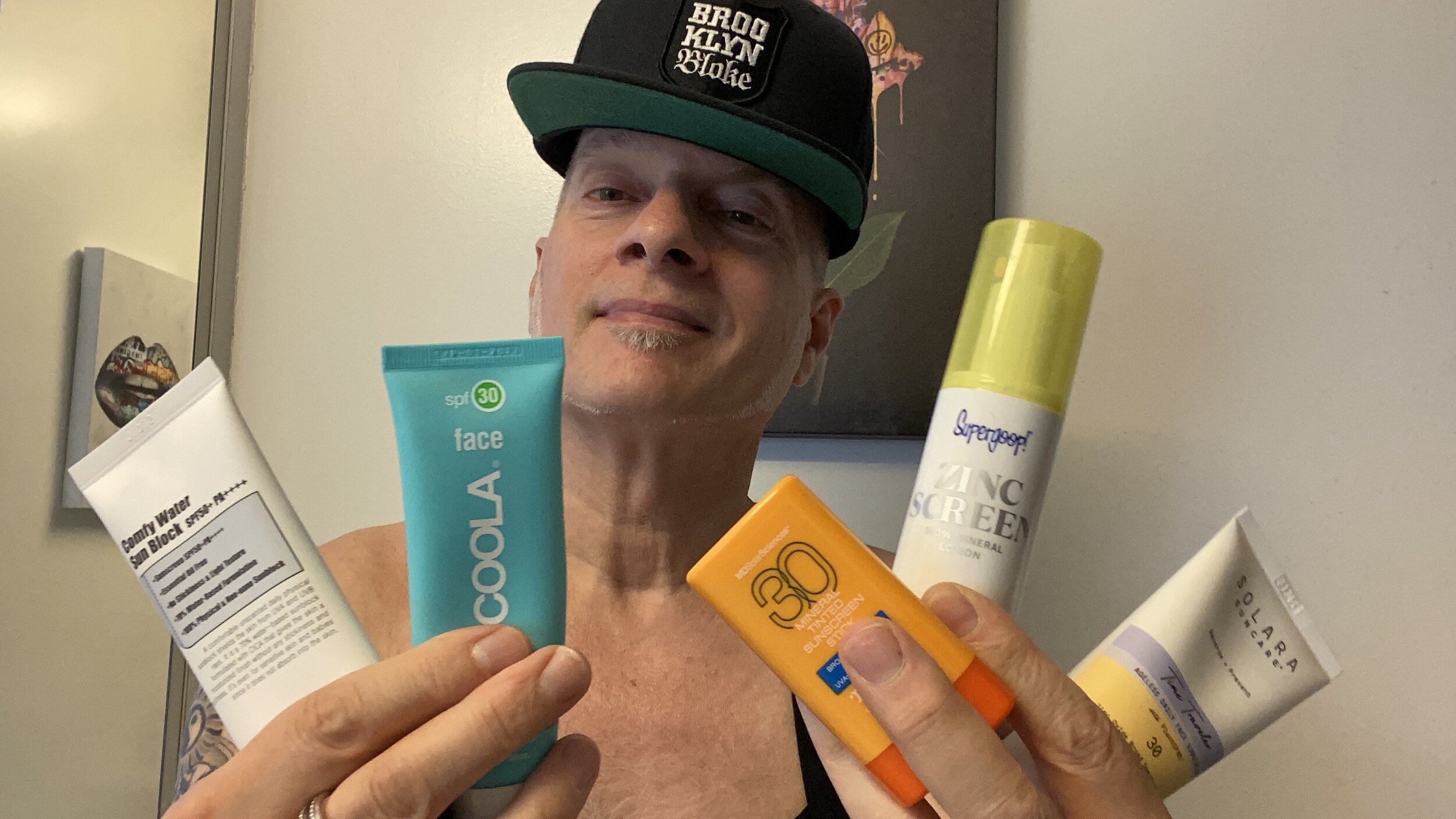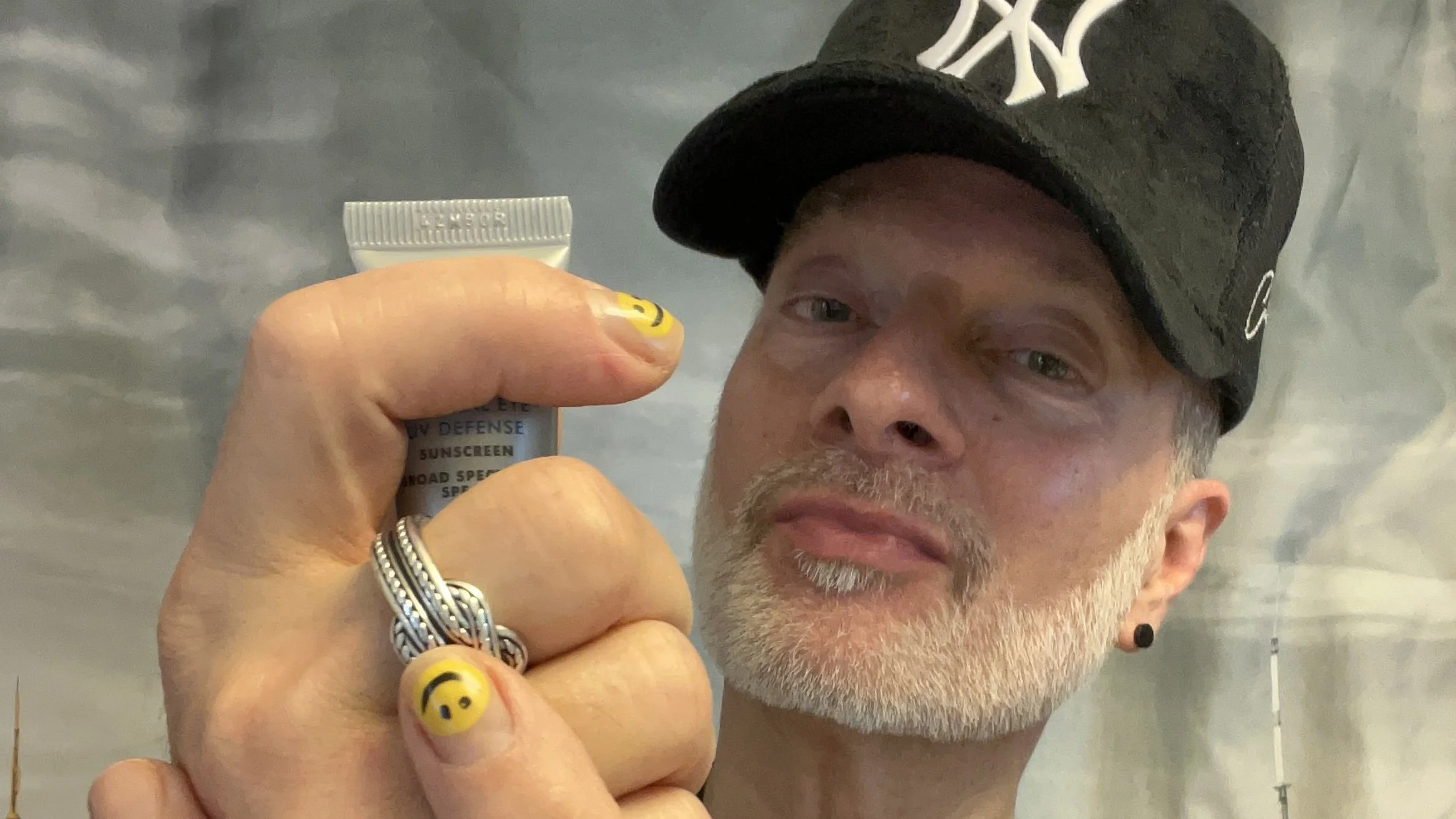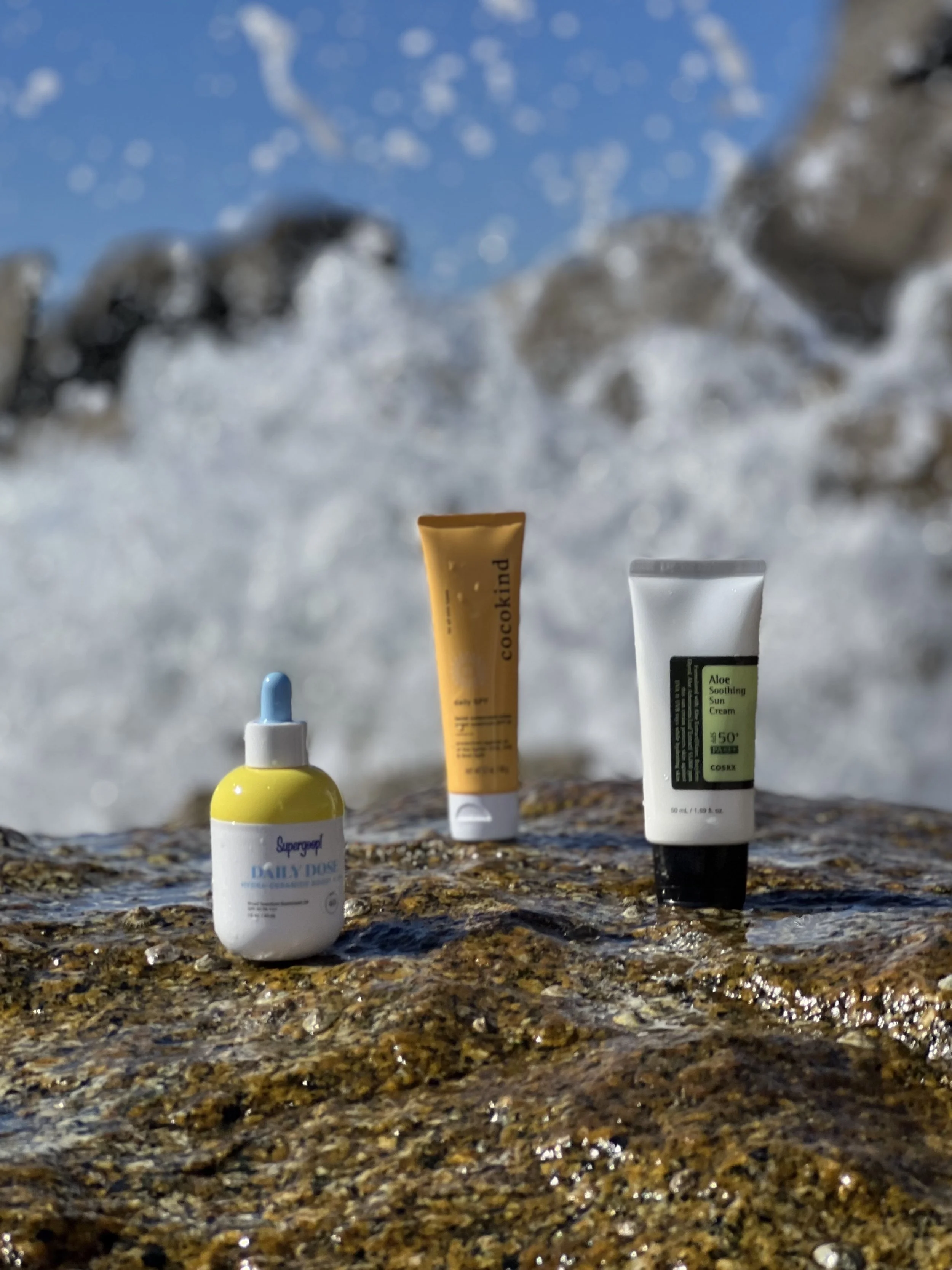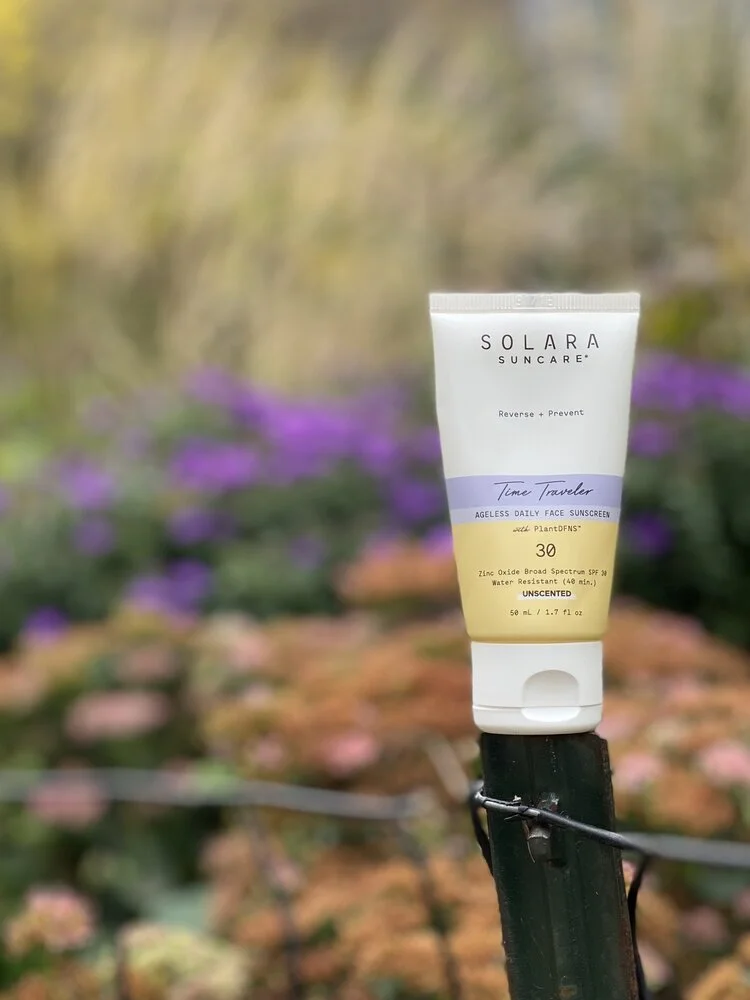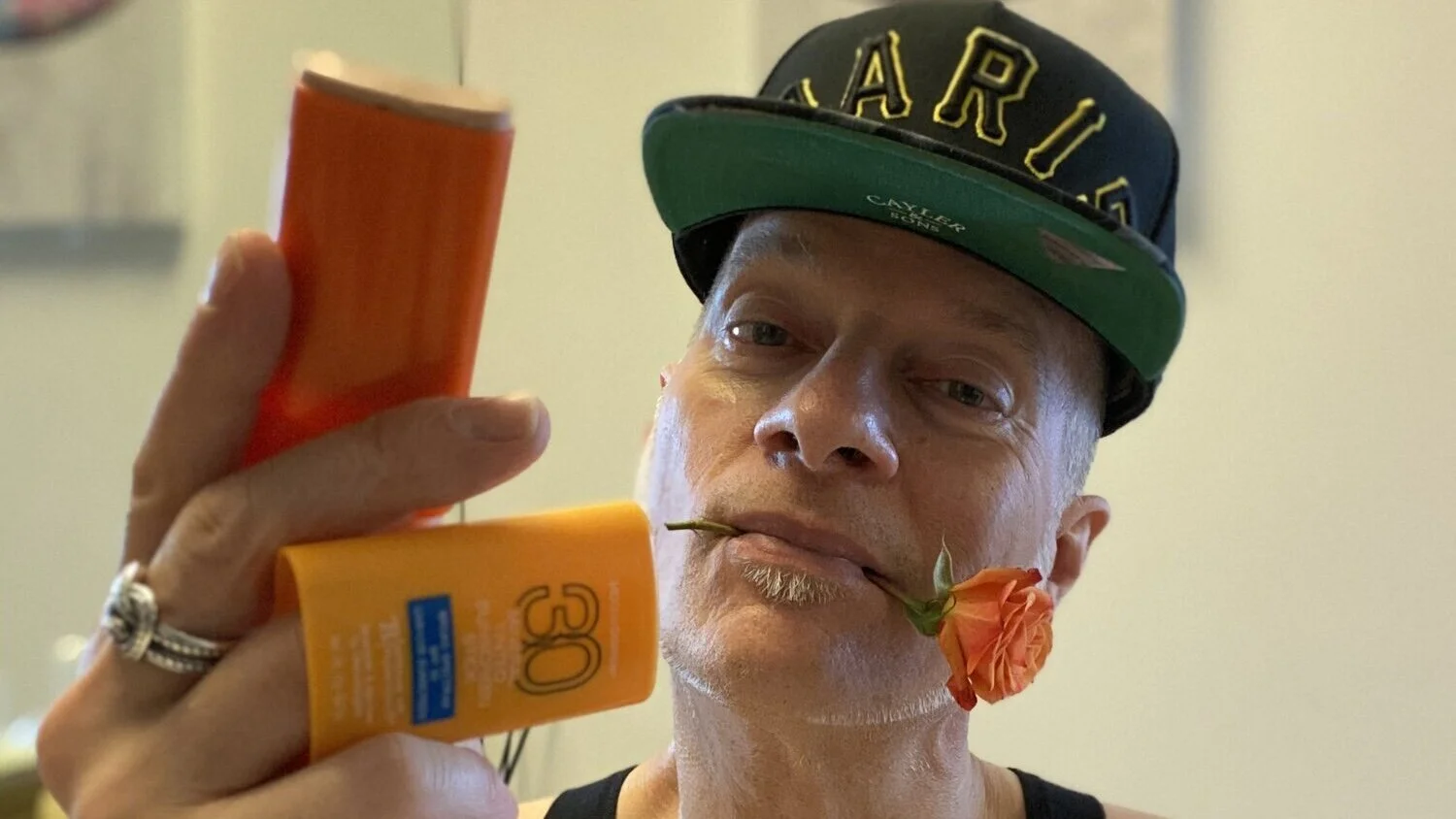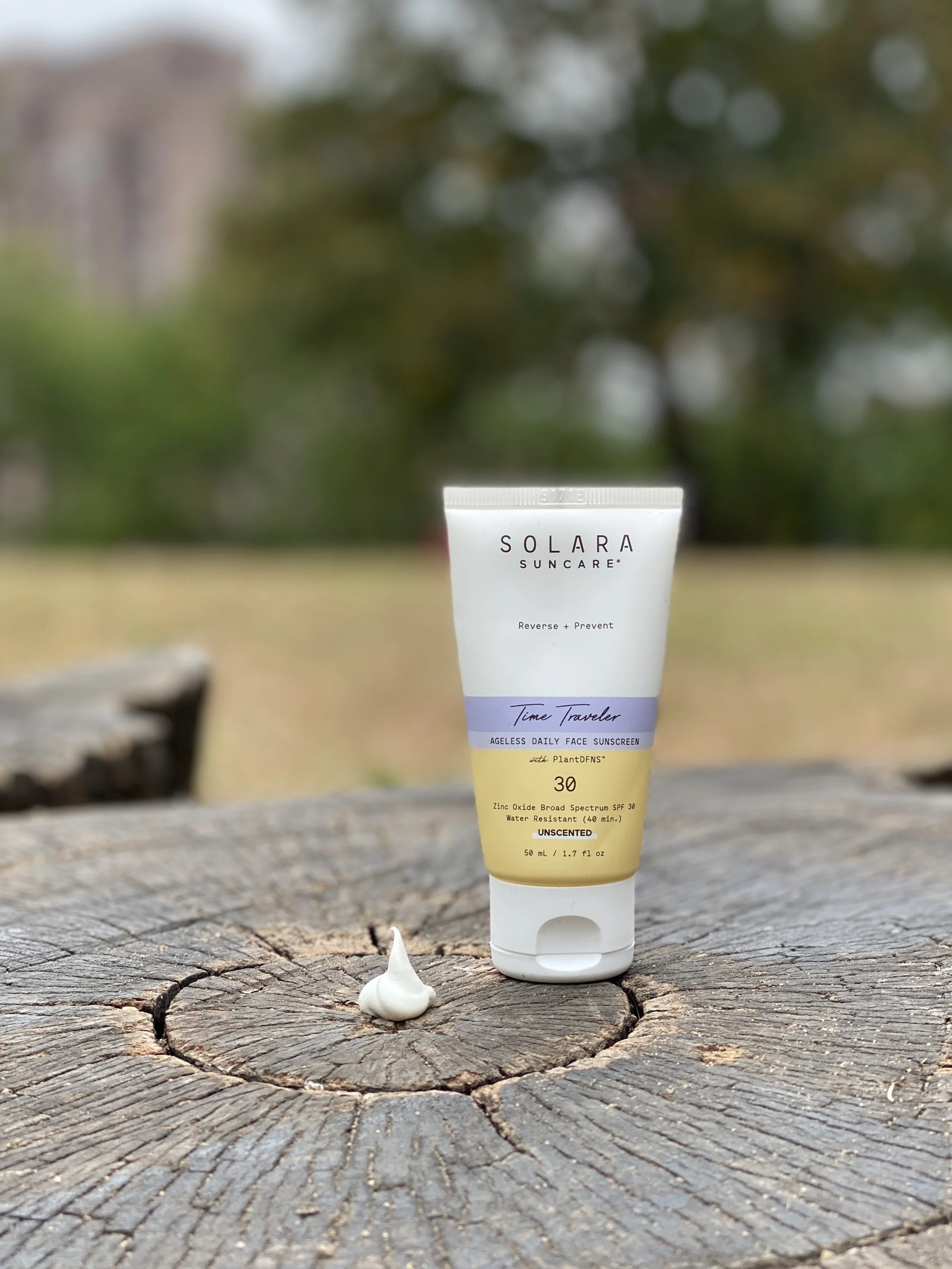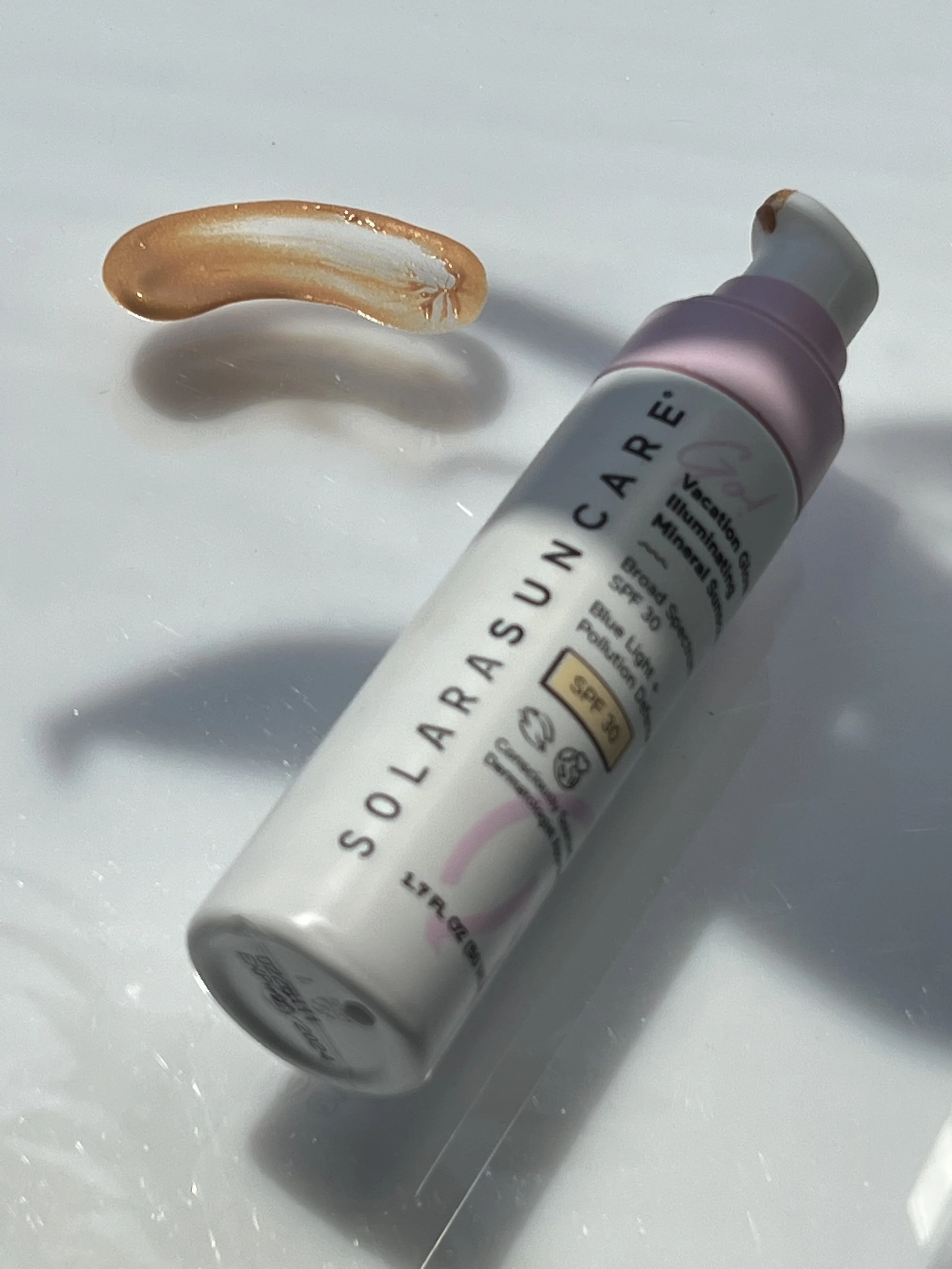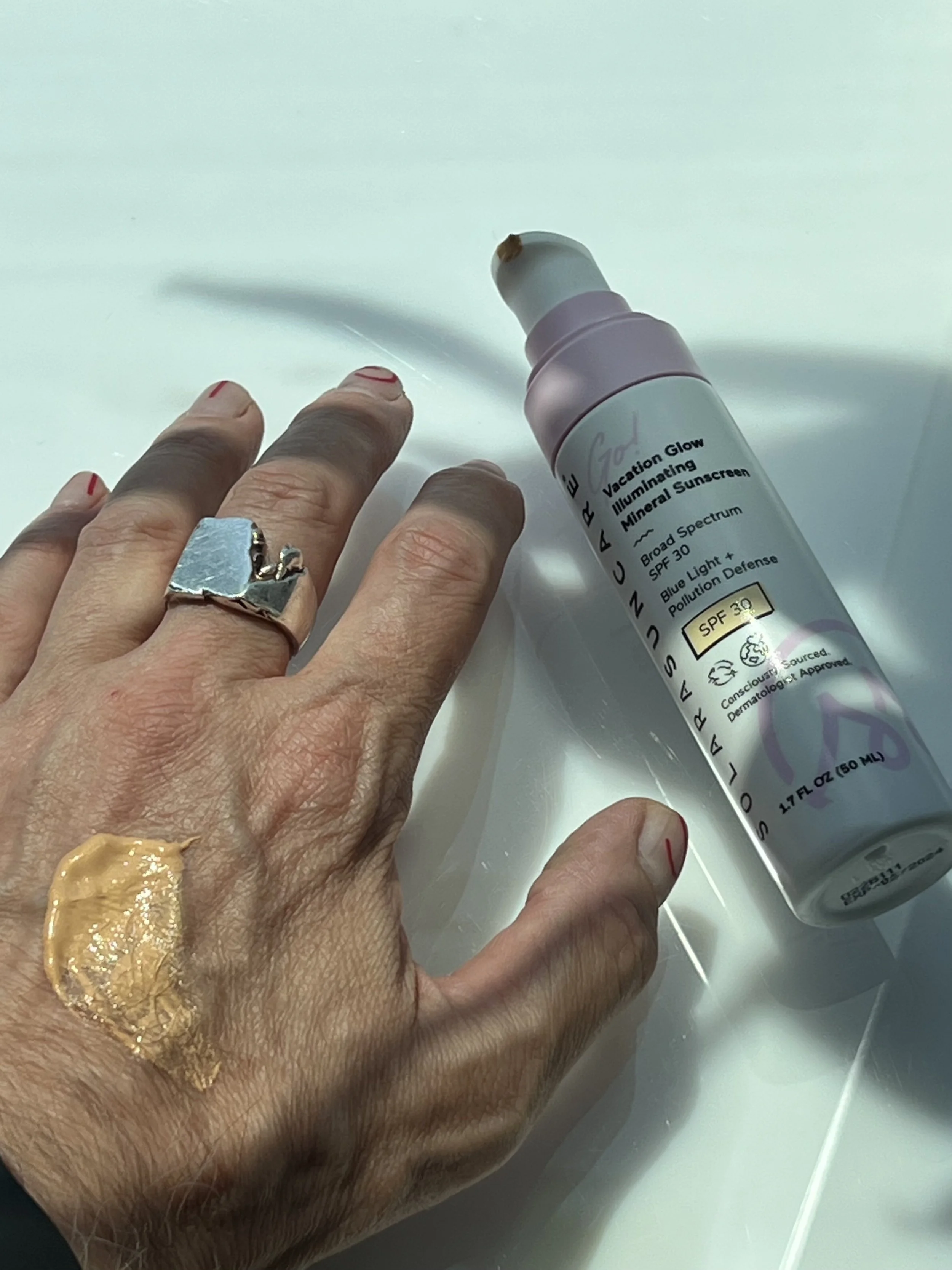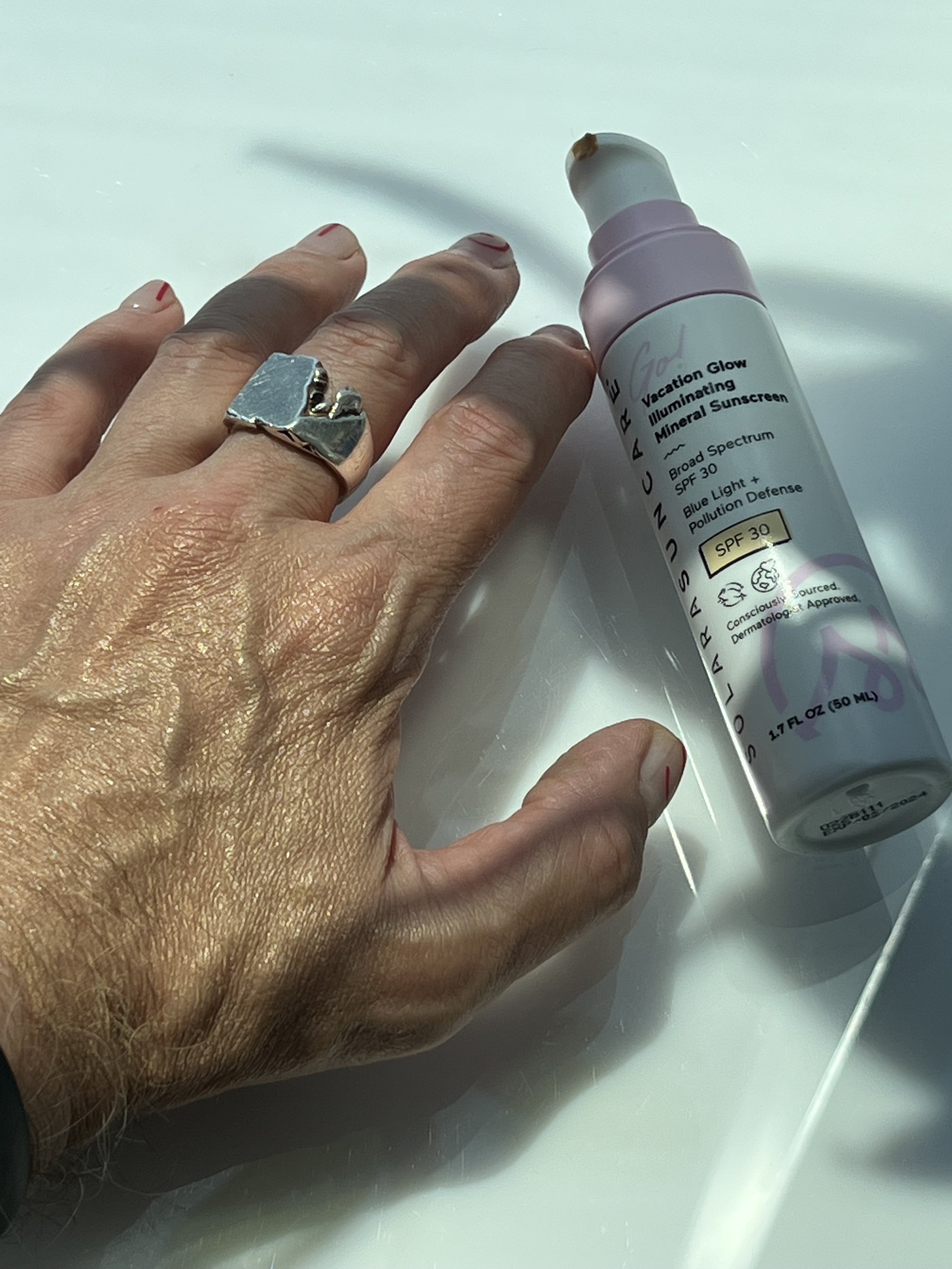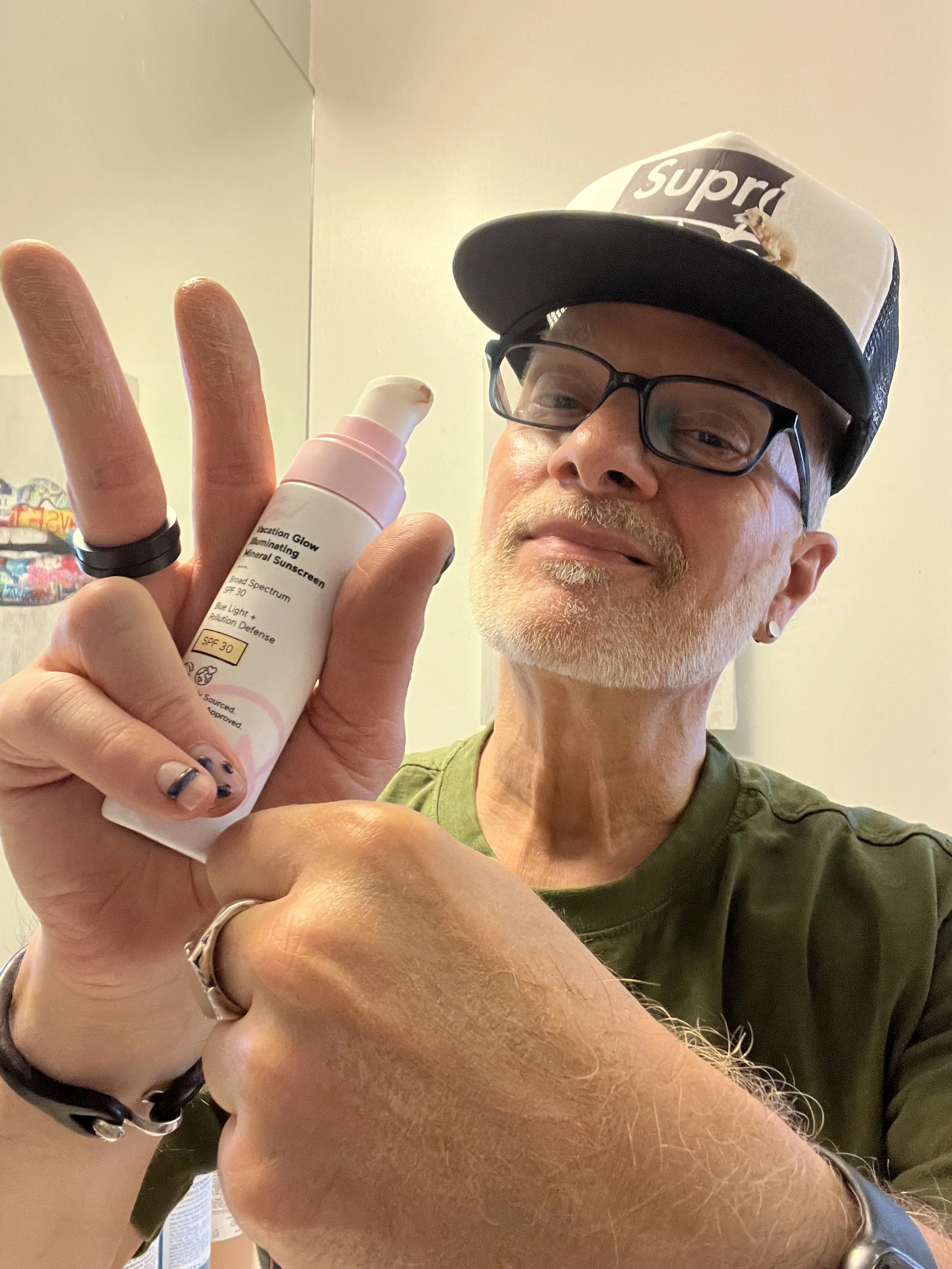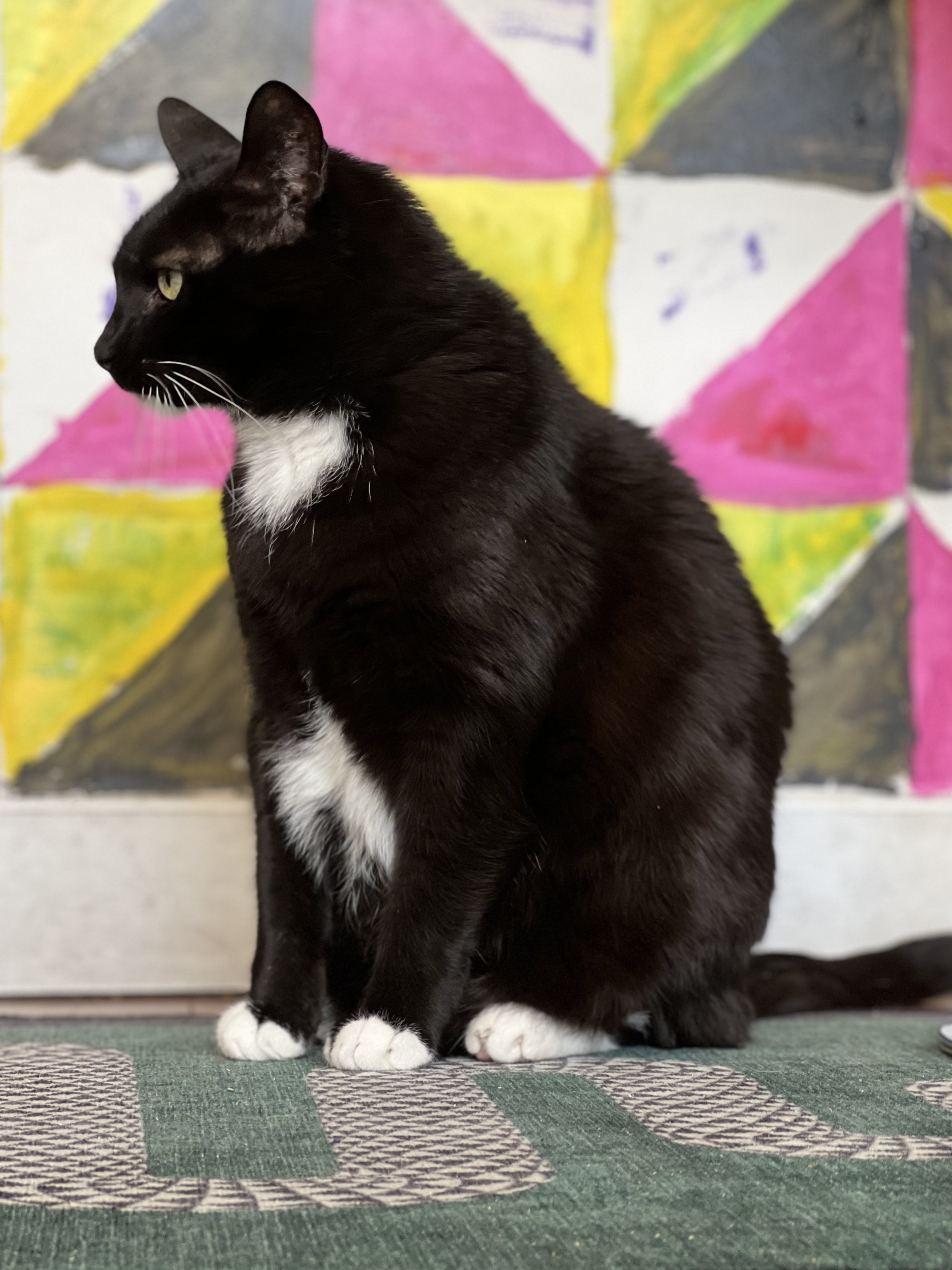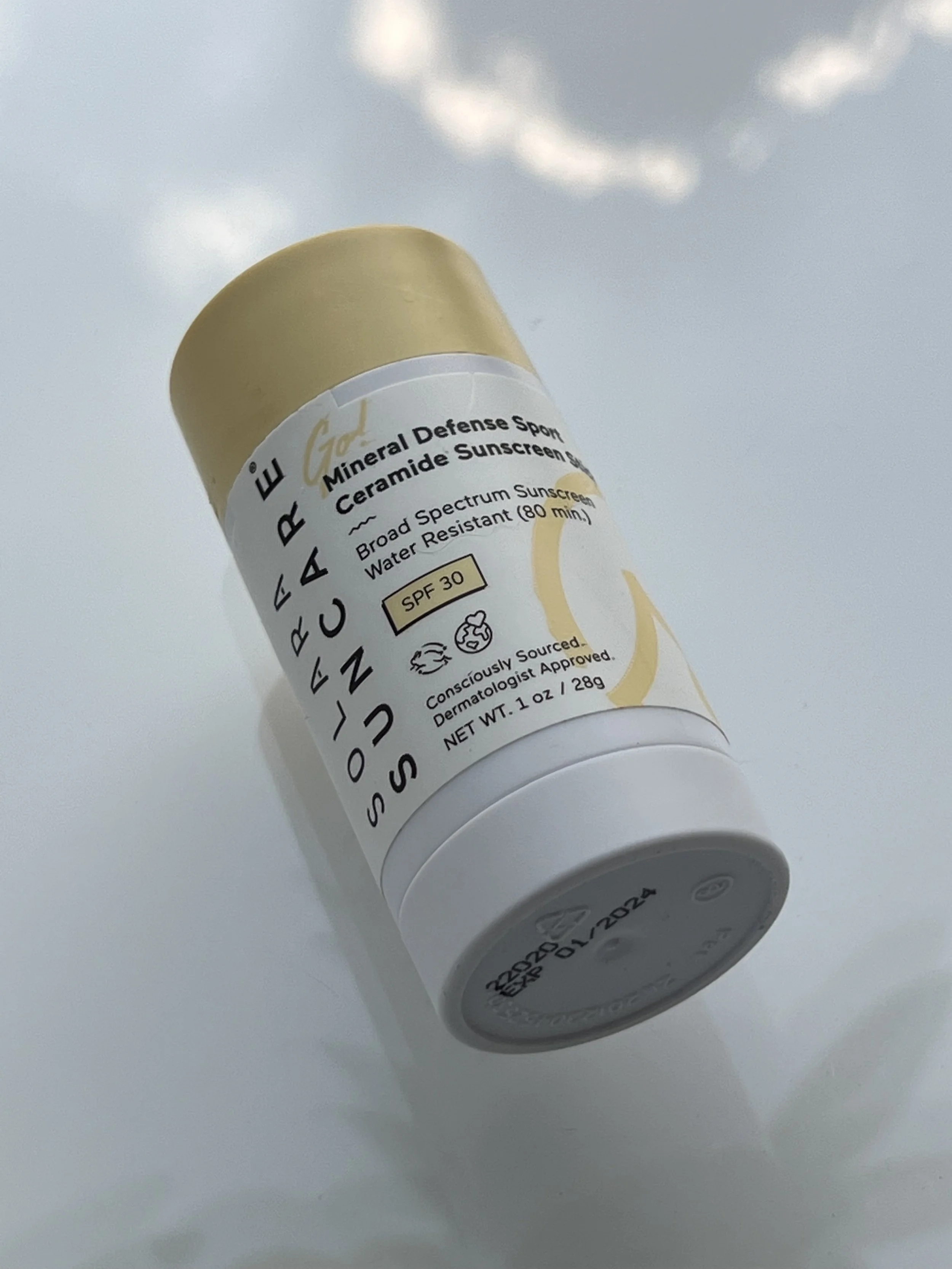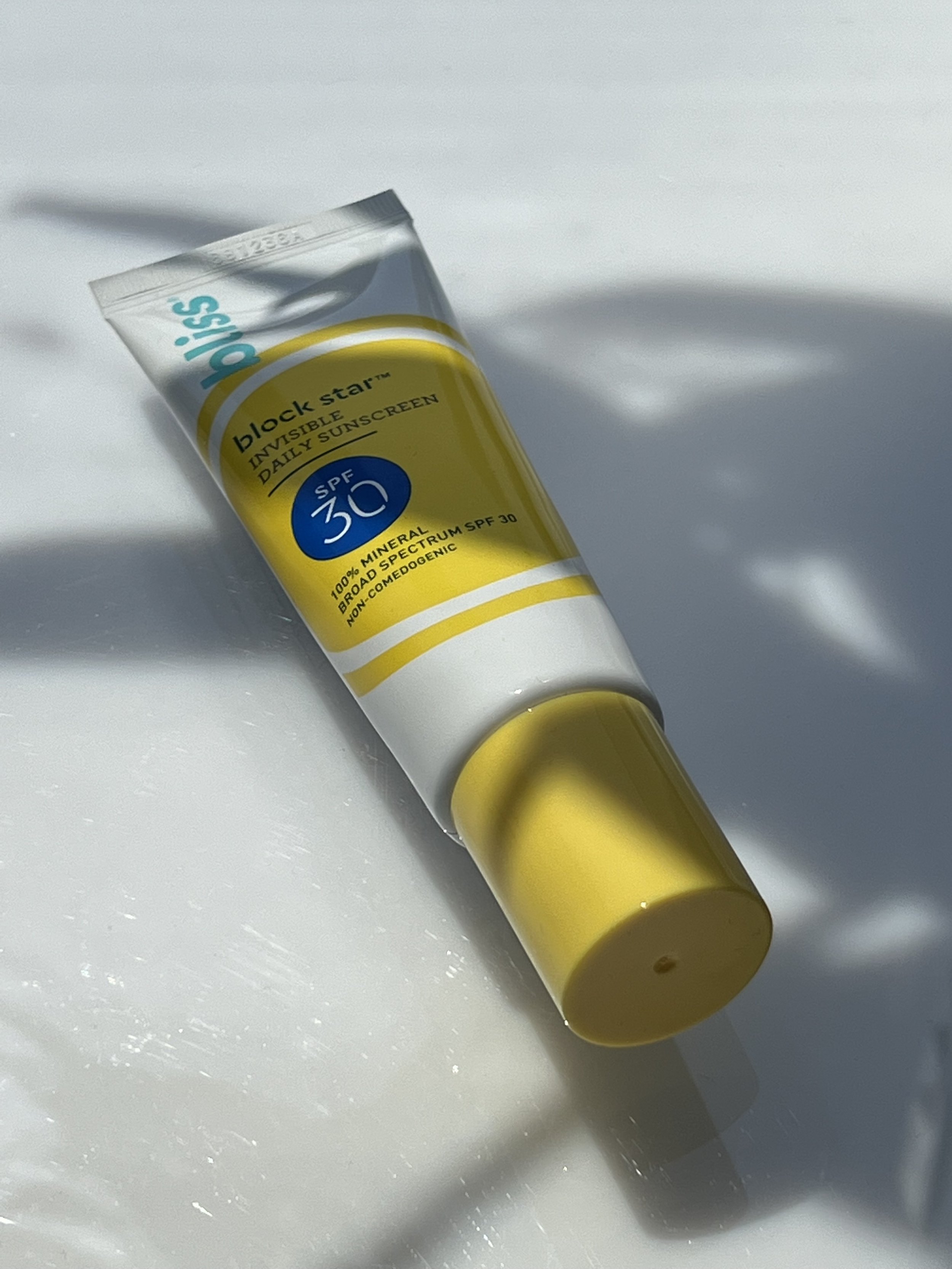PRODUCT REVIEW: SOLARA SUNCARE GO! VACATION GLOW ILLUMINATING MINERAL SUNSCREEN - BEST BB CREAM WITH SPF, BEST TINTED SUNSCREEN
SOLARA SUNCARE | GO! VACATION GLOW ILLUMINATING MINERAL SUNSCREEN
This product review was originally part of my blog article titled, Three Tinted Sunscreens I'm Obsessed with From Wander Beauty, Bliss and Solara Suncare - Best Tinted Sunscreen, Best Primer with SPF. You can catch the full piece here.
—
Like nearly everyone else on the planet, I love summer. And probably unlike most, I loathe the cold. My greatest trauma as a child was waiting for the school bus in bone-chilling zero-degree weather. It was during those character-building moments that my adult life in warm, sunny Los Angeles had its origins. I spent 15 years in LA before moving to New York to work for Kiehl’s at the age of 37.
And while I was always an avid user of sunscreen, including around my eyes, it wasn’t until I got to New York City, interestingly, that I really understood the importance of sun protection. It was then that I began to view a sunscreen for face as the most important and effective anti-aging treatment available. In fact, a face cream with SPF doubles as the best anti-aging cream for wrinkles and pretty much all other visible signs of aging.
Even today, with irrefutable evidence that the sun’s UV rays are the most damaging to the skin and the greatest factor in skin aging, skincare marketers fail at communicating the vital importance that a daily sunscreen plays in overall skin health. I guess it’s just not sexy enough and there isn’t enough money to be made.
Whether or not sunscreen is sexy is, of course, beyond the point. Whether or not you use an SPF for face is the sole determining factor in the health and youthful appearance of your skin at any age.
Unprotected sun exposure and the resultant UV damage is the leading cause of lines and wrinkles, loss of collagen, hyperpigmentation and dark spots. And that’s just a quick list of all the skin-aging downsides of not wearing sunscreen every day.
One of my most cherished learnings from my work at Kiehl’s, and my favorite of the brand’s many wisdoms, was that it’s essential to wear sunscreen even on cloudy, seemingly sunless days. Too many people make the mistake of thinking that they can outsmart the sun; that they don’t need sun protection in winter or on a cloudy day.
Truthfully, the sun’s rays always find a way to our skin. You cannot hide.
The Best Sunscreens For Face
It is essential to wear sunscreen even on cloudy seemingly sunless days.
Did you know that a lack of daily sun protection in the eye area can exacerbate the appearance of dark circles? Not using a sunscreen around the eyes actually makes dark circles worse.
I’ve had so many conversations with people lately about whether or not they use sunscreen in the immediate eye area, right inside the orbital bone. It’s no coincidence that the skin around the eyes is the first place to show signs of aging. In the eye area, skin is the thinnest of anywhere on the face. It’s the most exposed to UV damage, whether you wear sunglasses or not.
I recently posted a TikTok video about what I referred to as The Most Important Product You're (Probably) Not Using! (Psst…it’s sunscreen for the eyes!) You can catch the video along with my recommendations of the best sunscreen for eyes on the blog here.
The Most Important Product You're (Probably) Not Using!
What’s the Difference Between Mineral and Chemical Sunscreens?
While I prefer a mineral sunscreen, it’s not a dealbreaker for me. What’s most important is that you love using your facial sunscreen product. If you love using a chemical sunscreen, that’s perfectly okay. One of my all-time favorite daily sunscreens for face is the Supergoop! Daily Dose Vitamin C + SPF 40 Sunscreen Serum PA+++ — a 100% chemical facial sunscreen that’s such a pleasure to use. As crazy as it sounds, I look forward to applying it! (You can catch my review of Daily Dose on the blog here.)
What’s the difference between a mineral sunscreen and a chemical sunscreen – and is a mineral sunscreen better than a chemical sunscreen? For helpful insights, there’s an excellent article by the Paula’s Choice Research Team titled, Mineral vs. Synthetic Sunscreen Ingredients available here. In the piece, the experts explain the differences and benefits between the two — and even dispel a myth or two.
The two types of sunscreen ingredients are mineral and synthetic [chemical], and both are equally protective. Further reassuring is that each can be included in formulas created for every skin type. For example, if you have normal to oily skin, there are weightless, non-greasy options; if you have normal to dry skin, it’s possible to find skin-smoothing, hydrating SPF products.
What’s the Difference Between Mineral and Synthetic Sunscreen Ingredients?
The differences aren’t about which type is more effective; rather, it comes down to personal preference and how sensitive your skin is—mineral sunscreens are considered the most gentle options.
Mineral sunscreens: There are only two mineral sunscreen ingredients: titanium dioxideand zinc oxide. They work in skin's uppermost layers to both absorb and, to a lesser extent, deflect and scatter the sun’s harmful rays. These mineral ingredients are sometimes referred to as physical sunscreens or physical blockers, although that’s not a factual representation of how they work.
Synthetic sunscreens: There are over 30 synthetic sunscreen ingredients, all of which absorb into the top layers of skin, where they work similar to mineral sunscreens: by scattering and deflecting the sun’s harmful rays, and by converting UV rays into heat and “deactivating” them. (Don’t worry, you won’t feel a thing.) Common synthetic sunscreen ingredients include oxybenzone, octinoxate, octisalate, and avobenzone. These are sometimes labeled “chemical sunscreens,” which is both misleading and false. All skin care ingredients, even water, are chemicals.
—
Which Sunscreen is Best?
As we said, the right sunscreen for you is the one you’ll look forward to applying daily. It should be rated SPF 30 or higher and provide broad-spectrum protection to prevent damage from the sun’s killer UVA and UVB rays. Beyond that, to make an informed choice, you need to know how your skin type responds to different sunscreen ingredients and textures: those containing mineral actives, synthetic actives, or a combination of both.
Mineral sunscreens:
Begin to work immediately on application, but must be absorbed to be most effective and to ensure they don’t wipe off on clothing.
Have almost no risk of irritating skin.
May leave a white cast, especially on darker skin tones, but the best pure mineral sunscreens go on almost sheer.
May need more careful, liberal application because of the way they work in formulas. So, go ahead, slather these on for brilliant protection!
Do not penetrate past skin's uppermost layers.
Synthetic sunscreens:
Begin to work immediately on application, but must be absorbed to be most effective and to ensure they don’t wipe off on clothing.
Are generally found in products with thinner textures.
Tend to be preferred for water-resistant formulas because they don’t turn milky-looking when you sweat or get wet. But, as with any sunscreen, you must reapply them often.
Can be sensitizing for those with extra-sensitive skin.
Can penetrate the skin and be absorbed in small amounts that are not shown to have health risks.
Read the full article here.
THREE AMAZING SUNSCREENS I TOOK WITH ME TO CABO FROM SUPERGOOP, COCOKIND AND COSRX - BEST SUNSCREENS FOR FACE
So, an anti-aging sunscreen is a must for me. As is a sunscreen for the eyes. Chemical or mineral, it doesn’t matter. What matters is compliance. As one of my fave sunscreen brands, Supergoop!, says about wearing a facial sunscreen: Every. Single. Day.
Lately, I’ve been exploring tinted sunscreens, SPF with tint, and sunscreen primers — ideal for under makeup or alone. Funny, I have found that the right tinted sunscreen for face actually adds a little bit of color to my beard! Who knew?!
Over the last several weeks, I’ve tried maybe a half dozen or so tinted sunscreens and three of them stand out. I first reviewed the Wander Beauty Pack Up & Glow Priming Broad Spectrum SPF 40 Mineral Sunscreen on the blog at the start of spring. It has a super lightweight texture, a high level of mineral sun protection, and is a real pleasure to use.
Since I first discovered Solara Suncare in 2018, it’s become one of my go-to sunscreen brands. And Solara Suncare’s Time Traveler Ageless Daily Face Sunscreen SPF 30 is one of my favorite sunscreens of all time. You can catch my review of it on the blog here.
PRODUCT REVIEW: SOLARA SUNCARE TIME TRAVELER AGELESS DAILY FACE SUNSCREEN – BEST MINERAL SUNSCREEN
No Skincarma Blog review about sunscreen products and the importance of sun protection would be complete without mention of Jeanne and Susan, identical twin sisters.
Seriously, I can’t imagine a Skincarma Blog article about the best facial sunscreen products for the summer heat without an introduction to my friends Jeanne and Susan — identical twin sisters.
No, they're not my actual friends; in fact, we’ve never met. But I feel like I know them. As good friends would, they inspire me to be better — and to wear sunscreen every single day of the year. If you need proof of the very real effects of sun damage on your skin, look no further than these two ladies.
The sisters looked exactly alike growing up. But Susan has spent her life in Florida worshiping the sun (she’s also a heavy smoker!) while sister Jeanne lives in Ohio and has generally avoided overexposure to the sun (and smoking) throughout her life. While both were 61 when the adjacent photo was taken, a scientific study of Susan’s skin at Case Western Reserve University showed an 11-year age difference — Susan has extreme hyperpigmentation (sun spots), deeper wrinkles and degradation in skin elasticity.
Be a Jeanne, not a Susan!
The Best Sunscreens for Eyes
So I was excited to have the opportunity to try Solara Suncare’s new collection of on-the-go sunscreen products. Among my favorites from the range is the Solara Suncare Go! Vacation Glow Illuminating Mineral Sunscreen. The product spreads easily over the skin, unifies your complexion and leaves it with a subtle luminosity.
Last in the trio is the new Bliss Block Star Invisible Daily Sunscreen. It’s been a while since I tried a Bliss product and I wasn’t sure what to expect. I have to admit, I wasn’t expecting to be blown away. But I was! I love the texture and spreadability of Block Star.
Unlike the Wander Beauty Pack Up & Glow and Solara Suncare Vacation Glow sunscreens, Block Star has a mattifying effect – something I know I’ll appreciate on a 90-degree August day standing on the hot AF subway platform with my face melting down my neck and onto my new Supreme T-shirt.
With that, let’s take a look at the Solara Suncare Go! Vacation Glow Illuminating Mineral Sunscreen – one of the tinted sunscreens that has caught my attention as summer kicks off here in New York City…
Solara Suncare | Go! Vacation Glow Illuminating Mineral Sunscreen
As I’ve said, Solara Suncare’s Time Traveler Ageless Daily Face Sunscreen SPF 30 is one of my all-time favorite sunscreens for face. I first featured the brand’s Time Traveler Ageless Daily Face Sunscreen in a blog article on what I referred to as my dream skincare routine titled, A Complete $175 Clean Skincare Routine with Herbivore, The Inkey List, Solara Suncare & More! That was more than three years ago.
I love the Solara Suncare brand — and the incredibly functional, elegant sunscreens that the brand’s founder, Stephanie DiPisa, has created. So it was no surprise to me that the new Solara Suncare Go! Vacation Glow Illuminating Mineral Sunscreen would be just as exceptional.
BRANDS I LOVE: SOLARA SUNCARE, THE BEST CLEAN FACIAL SUNSCREENS! - BEST MINERAL SUNSCREEN FOR FACE
As the name indicates, Vacation Glow Illuminating Mineral Sunscreen is great for tossing in your weekend getaway bag. And I did exactly that on a trip upstate two weeks ago. To start, Vacation Glow has a lightweight creamy texture that lights up your skin as you apply it. Psst…if you’re looking for a mineral sunscreen with a tint, a subtle blurring effect and a shimmer, this is it!
As with all of the Solara Suncare facial sunscreens, the new Vacation Glow is much, much more than a mere sunscreen. It’s packed with multiple pro-skin health ingredients at relatively active levels. The top ten of the INCI is front-loaded with water-binding humectants and two solid antioxidant botanicals, including Acai Fruit Extract, and tried-and-true Green Tea Leaf Extract — one of the best antioxidant ingredients in skincare.
To me, antioxidants are as essential to skin health as sunscreen actives like Zinc Oxide. Both are key components in an effective anti-aging routine.
What Are Antioxidants and What Do Antioxidants Do for Skin?
Similar to safe sunscreen filters like Zinc Oxide, Titanium Dioxide and Tinosorb S and M, antioxidants possess numerous benefits for the skin, including preventing skin damage and multiple signs of aging like hyperpigmentation, wrinkles and loss of firmness. There’s an excellent article from the experts on the Paula’s Choice Research Team titled, How Antioxidants Fight the Signs of Aging that you can catch here. This is what I found most insightful:
Antioxidants for Skin Benefits
Antioxidants play a unique role when it comes to diminishing the appearance of fine lines and wrinkles. Years of environmental damage (including unprotected sun exposure—one more reason to apply that broad-spectrum sunscreen!) slowly chip away at skin’s natural ability to look and feel healthy. As this damage builds up, skin gradually loses its ability to recover and bounce back as it once did. It’s not an exaggeration to say that after years of damage, skin becomes overwhelmed, and its “look young systems” begin to slow down.
Antioxidants in skin care step in to help shield skin’s surface from further deterioration by calming stressed skin and defending against the visible effects of pollution —something all of us encounter on a daily basis.
What happens as a result of applying antioxidants to your face is truly impressive: Skin’s appearance begins to turn around! It regains a firmer feel and more even skin tone—and those wrinkles you’re probably not fond of will visibly soften.
Antioxidants for Your Skin: What Results You Can Expect?
Although we know that topical application of antioxidants in skin care helps to shield skin from ongoing environmental assault, the results aren't going to make you look 20 years younger—and they may take time to show up. Reality check: The claims attributed to these wonderful ingredients are more often than not overblown or a big stretch of what scientific research has shown to be true.
It’s best to think of antioxidants as part of a trifecta of beneficial ingredients you can use in skin care products to achieve and maintain visibly firmer, youthful-looking skin. Antioxidants should be joined by skin-replenishing ingredients like ceramides, hyaluronic acid, and glycerin plus a range of skin-restoring ingredients like retinol, peptides, and niacinamide. Together, these types of ingredients play a symphony your skin needs to hear—and you’ll love seeing the results every time you look in the mirror.
The trick is to be consistent with your skincare routine and make absolutely sure you’re protecting your skin from sun exposure every day with a broad-spectrum sunscreen rated SPF 30 or greater—and of course, it should be brimming with antioxidants, your skin’s new best friend.
The Solara Suncare Go! Vacation Glow Illuminating Mineral Sunscreen was one of the products I took along with me on a recent weekend getaway to Upstate New York. I didn’t know what to expect, but I trust Solara Suncare and tossed the new sunscreen in my dopp kit sight unseen. I hadn’t even opened it yet!
Over the course of the three days away, it was both seasonally warm and unseasonably cool – giving me a chance to test out the wearability and, most importantly, comfort of Vacation Glow in drastically varying temperatures. I found it perfectly wearable on my skin. It blended right in without looking like makeup, leaving only a subtle iridescence that gave me a healthy glow.
It’s a bit thicker than Wander Beauty’s Pack Up & Glow Priming Broad Spectrum SPF 40 Mineral Sunscreen and I’d almost go so far as to say Vacation Glow has the qualities of a BB Cream. Hmm…is it a BB Cream?!
What’s the percentage of UV rays blocked by sunscreen?
SPF 15 blocks 93% of UVB rays
SPF 30 blocks 97% of UVB rays
SPF 50 blocks 98% of UVB rays.
So, the difference in UV rays blocked by SPF 30 and SPF 50 is about 1 percent.
I found a great piece on BB Creams on the Byrdie website titled, The Fascinating Rise of BB Cream and Why We're Forever Hooked.
Similarly to a foundation, BB creams vary in coverage, color, and finish (matte, natural, or dewy). But unlike a makeup foundation, which focuses solely on color and coverage, a BB cream goes a step further with added skincare benefits, such as hydration and sun protection. “The main benefit of BB Cream is that it offers a sheer source of hydration," says [celebrity makeup artist] Sir John. "It also offers a tint to the skin with easy maneuverability, making it a quick option for Zoom calls, for example.”
With 19% non-nano, non-coated Zinc Oxide, Vacation Glow has got solid sun protection along with a nice cocktail of hydrators and protective antioxidants – and subtle skin-unifying coverage that evens out your skin tone quite nicely.
What I like about it: The Solara Suncare Go! Vacation Glow Illuminating Mineral Sunscreen is a really well-formulated facial sunscreen and quite affordable, too. I love the brand and would only expect a superior formula, which is what Vacation Glow is. Again, it has many of the qualities of a conventional BB Cream and, yes, is perfect for a weekend getaway – or as a daily sunscreen with tint.
What I don’t like about it: There’s nothing I don’t like about this one.
Who it’s for: All skin types, except very oily and acne prone.
SHOP THE BLOG: Purchase the Solara Suncare Go! Vacation Glow Illuminating Mineral Sunscreen for $32.99 here.
The Ingredient List of the Solara Suncare Go! Vacation Glow Illuminating Mineral Sunscreen:
Water (Aqua), Caprylic/Capric Triglyceride, Coconut Alkanes, Cetearyl Alcohol, Glycerin, Aloe Barbadensis Leaf Juice, Coco-Glucoside, Euterpe Oleracea (Acai) Fruit Extract, Camellia Sinensis (Green Tea) Leaf Extract, Helianthus Annuus (Sunflower) Sprout Extract, Hydrolyzed Jojoba Esters, Butyrospermum Parkii Nut Extract, Caesalpinia Spinosa Fruit Pod Extract, Caprylhydroxamic Acid, Glyceryl Caprylate, Cetearyl Glucoside, Caprylyl/Capryl Glucoside, Coco-Caprylate/Caprate, Polyhydroxystearic Acid, Polyglyceryl-3 Polyricinoleate, Isostearic Acid, Lecithin, Dipotassium Glycyrrhizinate, Sodium Phytate, Propylene Glycol, Xanthan Gum, Sclerotium Gum, Phenoxyethanol, Sodium Benzoate, Tocopherol, May Contain +/- Iron Oxides (Ci 77491, 77492, 77499), Mica, Titanium Dioxide.
WATCH MY VIDEO REVIEW OF
COOL CLEAN FACIAL SUNSCREENS TO KEEP US SAFE AND SMILING IN THE SUN
ON MY YOUTUBE CHANNEL HERE
WATCH MY VIDEO REVIEW
THE BEST NIACINAMIDE SERUMS FOR CLOGGED PORES AND A BRIGHTER COMPLEXION
ON MY YOUTUBE CHANNEL HERE
WATCH MY VIDEO REVIEW
THE SKINCARMA PRODUCT OF THE YEAR: BALM LABS 3-STEP REGIMEN - BEST ACNE REGIMEN, BEST CBD SERUM
ON MY YOUTUBE CHANNEL HERE
WATCH MY VIDEO REVIEW OF
SKINCARE HACKS: GLYCOLIC ACID IS THE NATURAL DEODORANT THAT WORKS!
ON MY YOUTUBE CHANNEL HERE
WATCH MY VIDEO REVIEW
COOL CLEAN FACIAL SUNSCREENS TO KEEP US SAFE AND SMILING IN THE SUN!
ON MY YOUTUBE CHANNEL HERE
WATCH MY VIDEO REVIEW
THE YEAR’S BEST VITAMIN C SERUMS WITH PAULA'S CHOICE, SUNDAY RILEY, THE INKEY LIST AND MORE!
ON MY YOUTUBE CHANNEL HERE
WATCH MY VIDEO REVIEW
THE BEST HYALURONIC ACID SERUMS FROM PAULA'S CHOICE, THE INKEY LIST, GHOST DEMOCRACY & MORE
ON MY YOUTUBE CHANNEL HERE
WATCH MY VIDEO REVIEW OF
A SELFCARE SUNDAY NOT FOR THE FAINT OF HEART – WITH THE PAULA’S CHOICE 25% AHA PEEL!
ON MY YOUTUBE CHANNEL HERE
WATCH MY VIDEO REVIEW
MY 2021 VITAMIN C PICKS + THE BEST VITAMIN C SERUMS TO BRIGHTEN UP THE COMPLEXION!
ON MY YOUTUBE CHANNEL HERE





